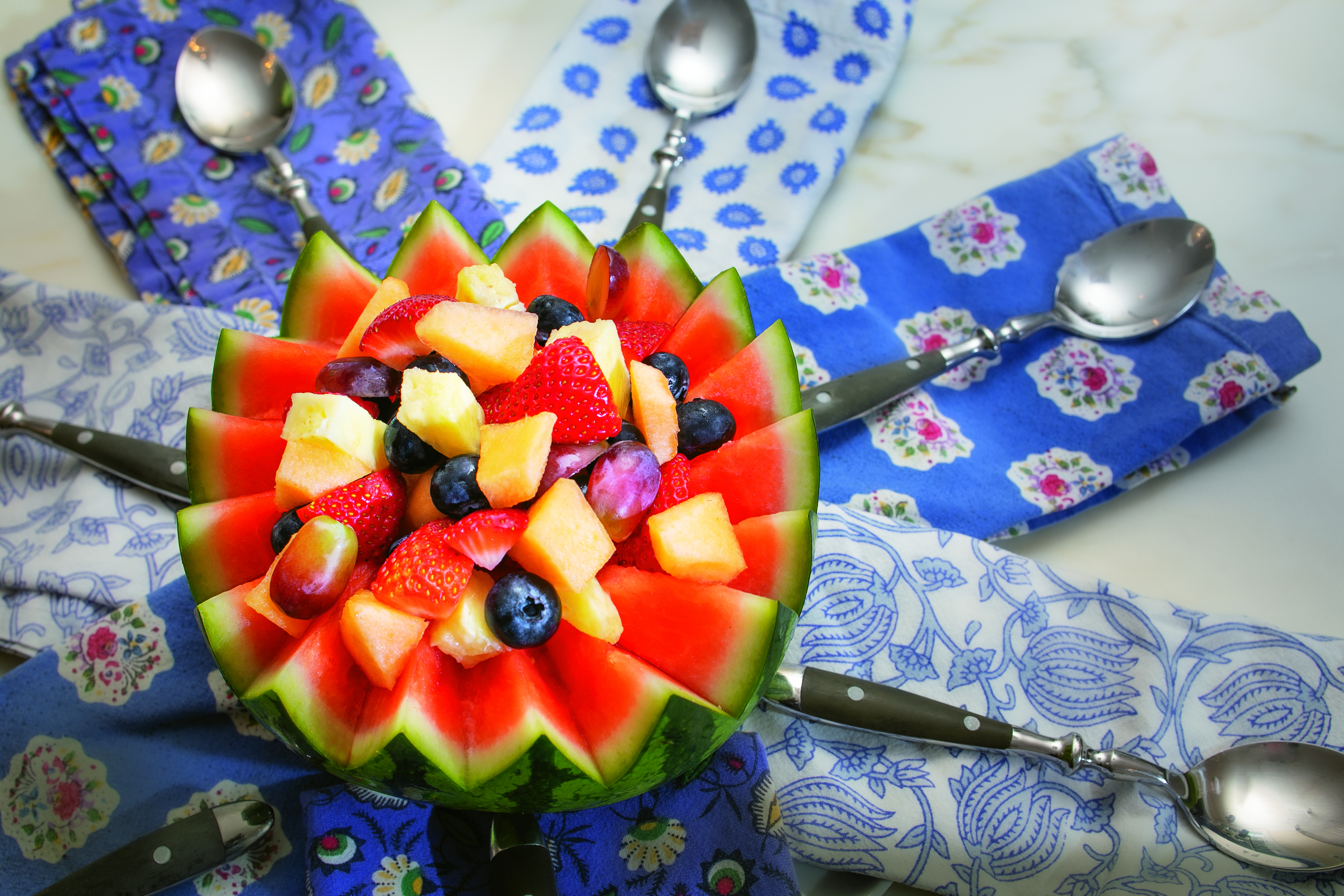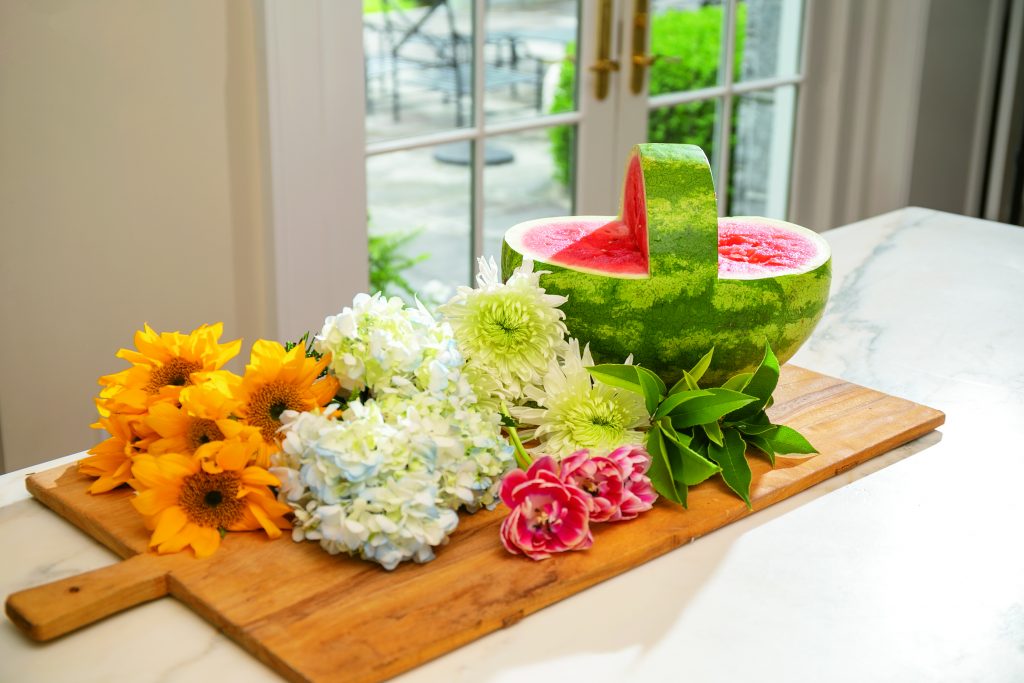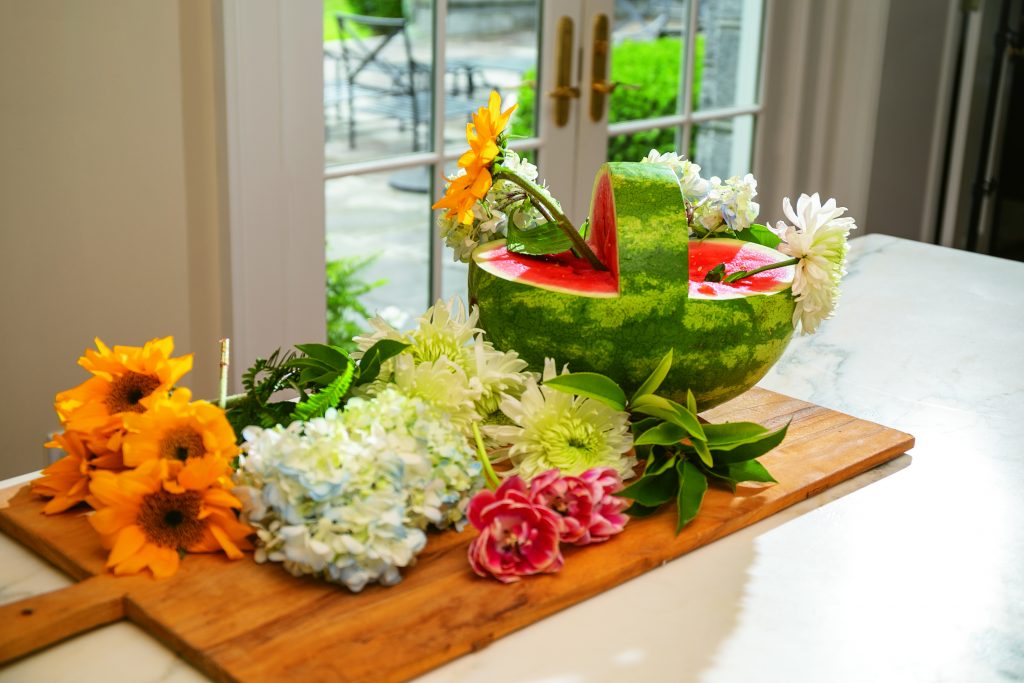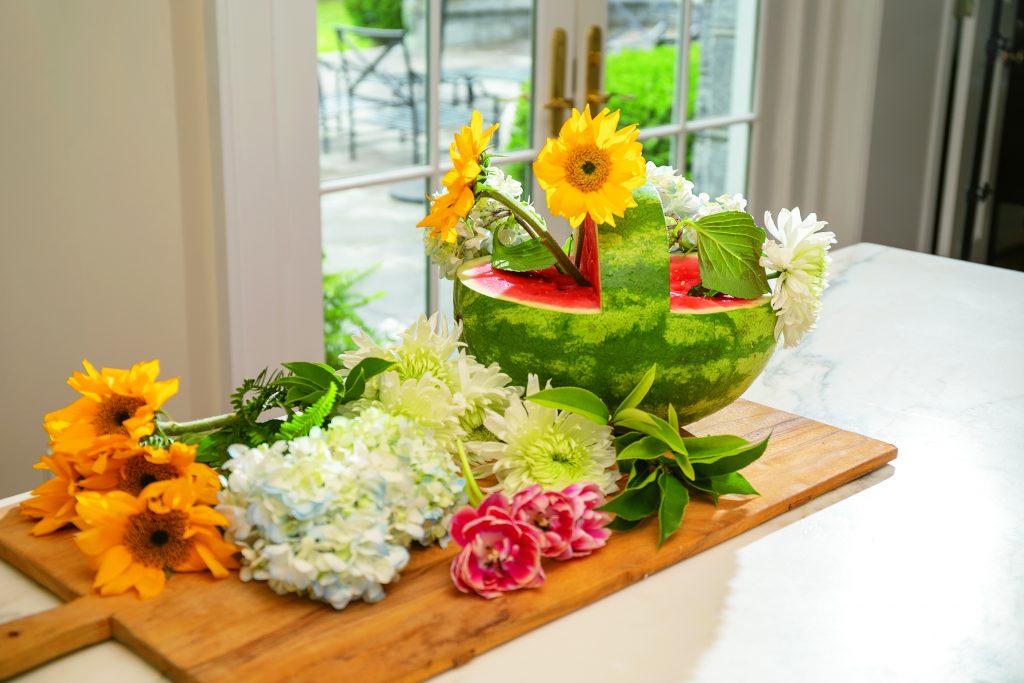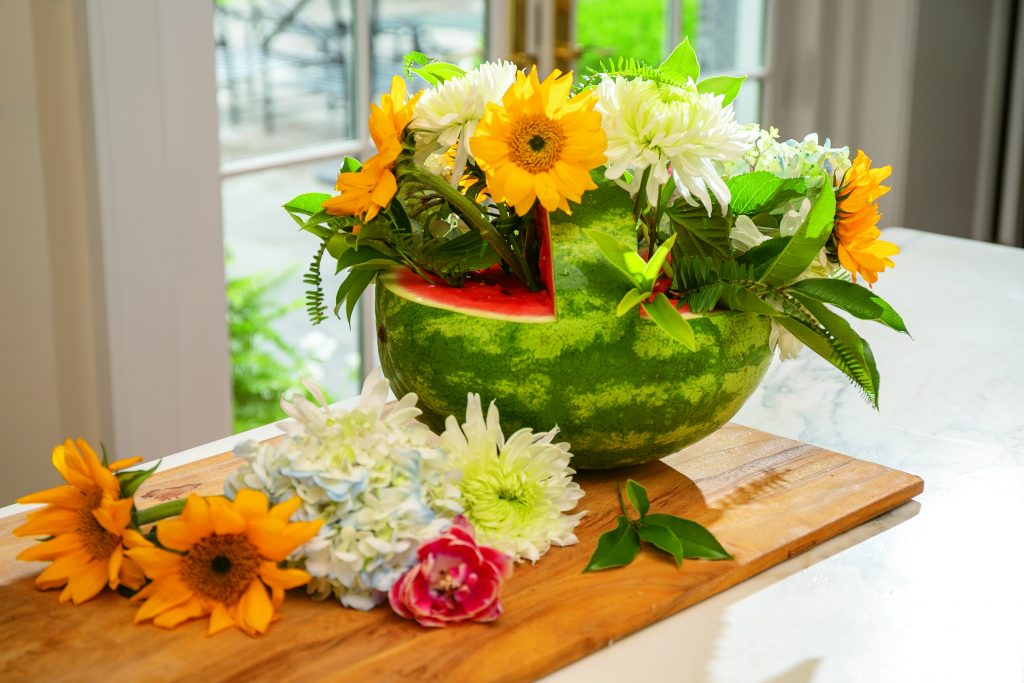
Mark Twain best summed up America’s adoration for that succulent symbol of summer when he said, “When one has tasted watermelon, he knows what the angels eat.”
And as the angels sit on their clouds, their wings sticky with nectar, we mere mortals can revel in the pure joy that comes from biting into the first ripe watermelon slice of the season — laughing, eating, and occasionally spitting a few seeds. All across the country, thousands of watermelon fans gather for festivals, often wearing watermelon inspired clothing and makeup, ready to sample the latest in watermelon lotions, lip balm, candy, and gum, as well as a plethora of unusual, and sometimes unsettling, watermelon dishes and drinks.
These festivals are ripe for those wishing to break some of the long-standing watermelon-based world records, such as the largest specimen (350.5 pounds), the most crushed with a head in one minute (49), the most eaten in 30 seconds (1 1/2 pounds), and the farthest a watermelon seed has been spat (75 feet, 2 inches). The trick to the last endeavor is to moisten your mouth with a little watermelon, choose a large seed, then roll your tongue, creating a channel for the seed to traverse, while simultaneously blowing as hard as possible.
Abraham Lincoln was a watermelon devotee, and in 1853 he christened his namesake community of Lincoln, Nebraska, by slicing open a melon and pouring the juice onto the ground. That memorable occasion has been commemorated with a two-foot steel replica of a watermelon slice, known as the Lincoln Watermelon Monument.
Watermelon is so hugely popular that it not only gets its own National Watermelon Day Aug. 3, but it also boasts a whole National Watermelon Month to be celebrated in July, although perhaps the angels can explain why those two events do not coincide. While watermelon was undoubtedly heaven sent, that delivery happened some 5,000 years ago. First harvested in ancient Egypt, watermelon is represented in several hieroglyphic engravings, although, disappointingly, these etchings do not depict ancient Egyptians spitting seeds at one another. Rather, watermelon is pictured as a gift devotedly bestowed upon royalty, or as an on-your-way-to-the-afterlife treat buried alongside their kings.
Later, watermelon traveled on merchant ships, eventually landing in China, where it was so beloved, the country ultimately became the world’s largest producer. Because watermelon is 92 percent water, explorers traveling the globe often used their melon merchandise as canteens. In America, farmers now produce more than 4 billion pounds of watermelon annually, making it the most-consumed melon in our country.
Botanists are adamant that watermelon is a fruit because it is produced from pollinated flowers and is chock full of plant-producing seeds. They go even further out on the vine and proclaim it a berry, as it is coreless and entirely edible. Some gardeners, however, consider watermelon to be a vegetable because these plants are frequently grown in vegetable gardens using the same techniques necessary to produce a crop of beans, peas, and corn. And watermelon planting and harvest schedules make them, at the very least, vegetable-wanna-bes, even if the scientific community isn’t willing to embrace them as such. The 2007 Oklahoma Legislature even gave homage to this juicy delicacy by naming it the state’s official — vegetable.
Oh, well. The debate rages on.
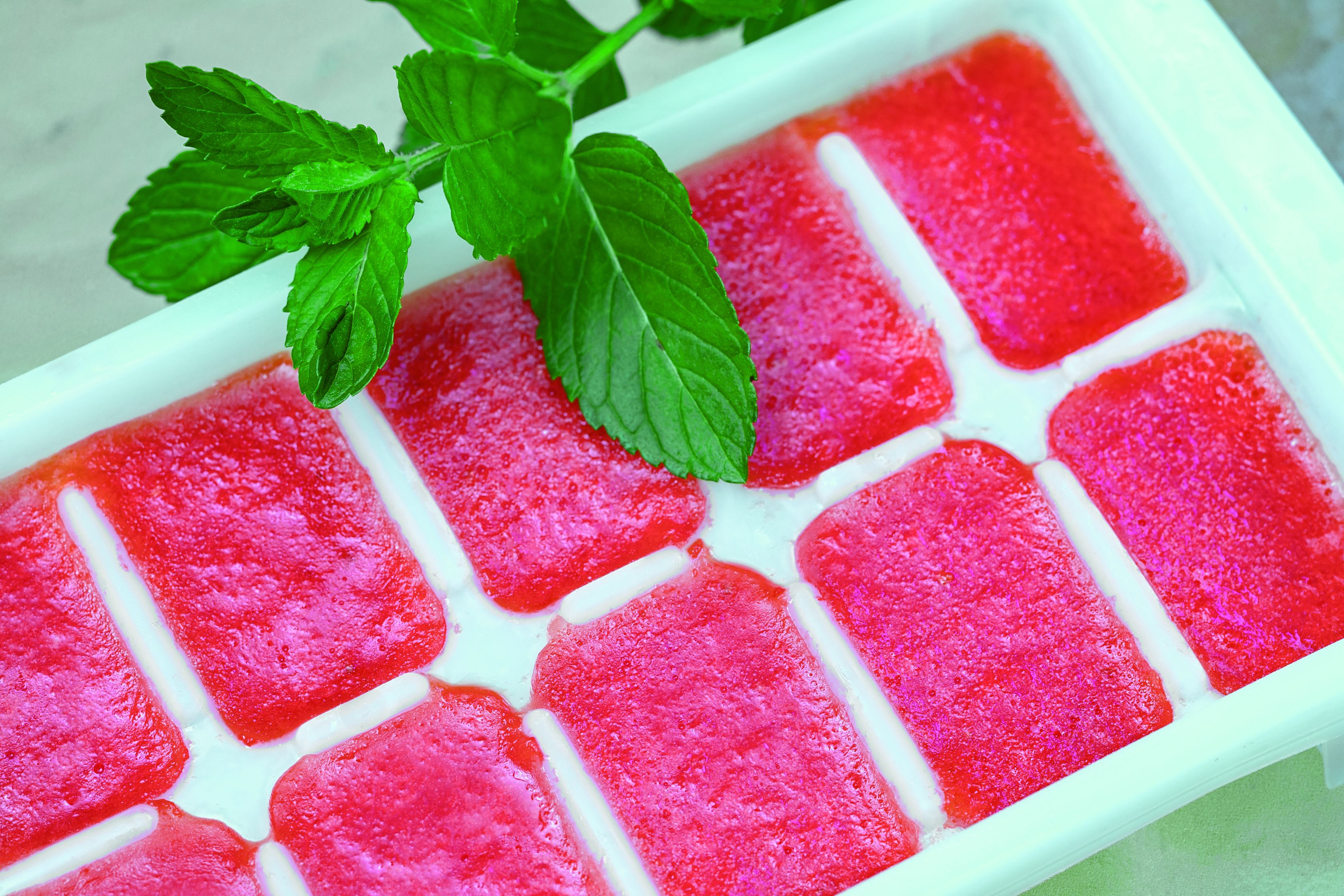

More than 300 varieties of watermelon are grown in the United States, but the most common are the classic seeded, the mini, the surprising yellow or orange flesh-colored melon, and the relative newcomer to the table, the seedless watermelon. Invented a little more than 50 years ago, perhaps by a mother tired of telling her children to quit spitting seeds at each other, seedless watermelons are now produced through the processes of genetic modification. They are a sterile hybrid — thus the lack of seeds — that is created by crossing two plants with different sets of chromosomes, much like crossing a horse with a donkey to produce a mule, but with much less risk of getting kicked.
Any type of watermelon requires hot, sunny weather, raised beds, and anywhere from 85 to 100 days to ripen, after which a pale yellow spot will appear on the bottom of the fruit, indicating it is time to be picked. But in some places in the world, watermelon farmers think outside of the box and create a crop that is, actually, a box.
Cube-shaped watermelon is popular in Japan, where farmers place the growing fruit in glass molds so that, as it matures, it takes the form of a box. Unfortunately, because they attain the desired shape before they have completely ripened, these weirdly appealing cube-shaped melons are not edible. They are generally given as very expensive gifts, ranging in price from $100 to $300, or are used as home decorations.
Pyramid and heart shaped watermelons are created using a similar technique, as are the incredibly creepy face-bearing versions that grow into a replica of a human head, complete with eyes, nose, and mouth. It’s probably just as well that they are also not edible because no one wants to cut into a melon that is staring back at you.
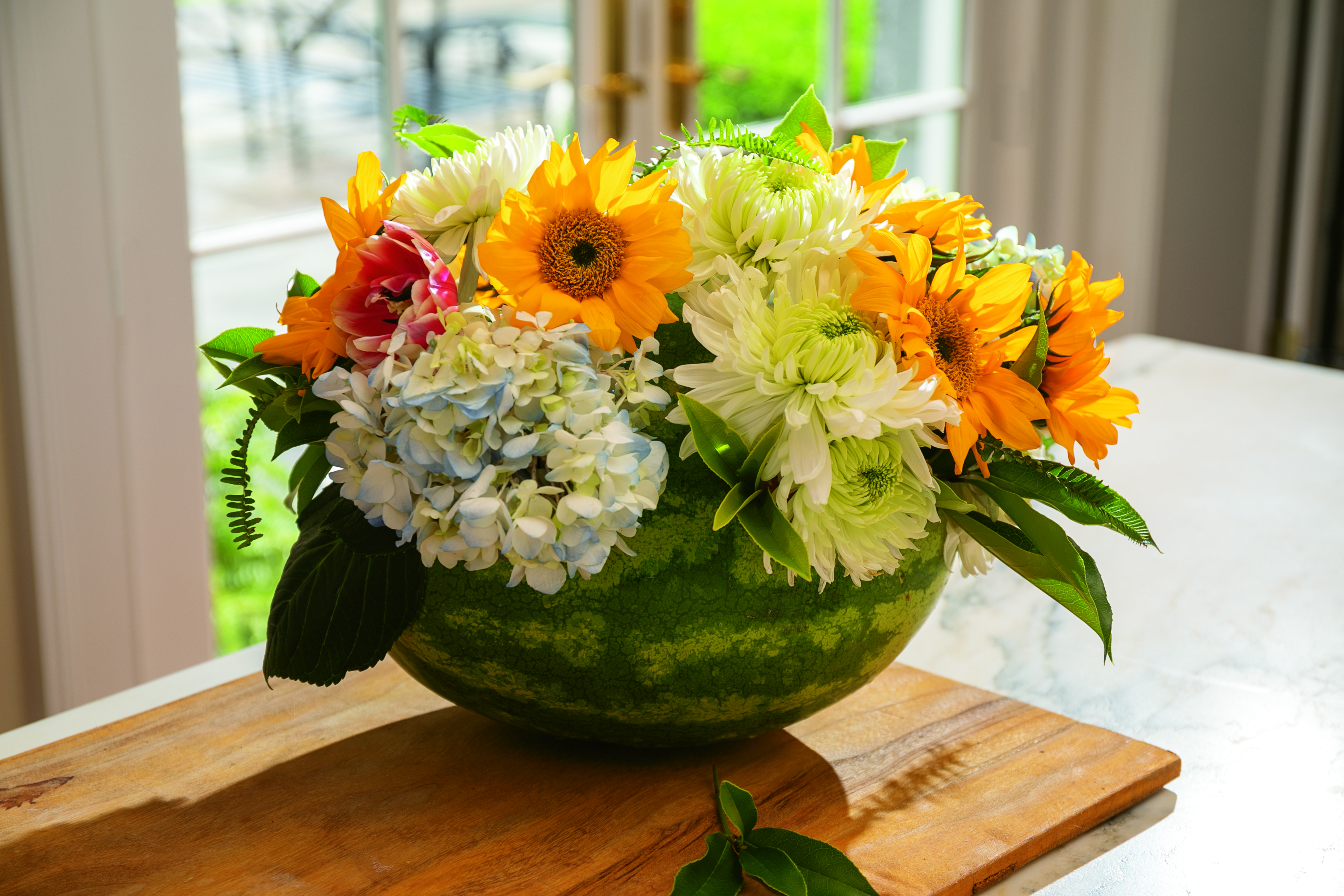
If you are planning on eating rather than displaying your watermelon, look for a heavy, firm fruit, with symmetrical coloring and no gashes or dents. Oval watermelons contain more water, and the rounder varieties tend to be on the sweeter side. While a good hard thump is a time-honored and satisfying way to check for ripeness because a ripe watermelon is said to have a more hollow side, a better method is to turn the watermelon over and search for a golden-yellow spot on the undercarriage, a sure sign that the watermelon is good to go.
Once you’ve gotten that watermelon home, feel free to eat the whole thing; that’s how it got its very berry stamp of approval. The rinds can be stir-fried or stewed, and seeds can be dried and toasted, just like what is often done with the watermelon’s close cousin, the pumpkin. Incidentally, pumpkin is also a fruit.
Surprisingly healthy, with only 40 calories per cup and plenty of antioxidants, vitamin C, and fiber, watermelon is also extraordinarily budget-friendly, with one large melon able to satisfy up to three dozen people. No wonder watermelon is the wildly popular, fantastically flavored fruit it is today. Apologies to Oklahoma, but it is a fruit.
Watermelon Limeade
Made tart or sweet, this drink just tastes like summer.
7 cups cubed seedless watermelon, rind removed
3/4 cup of fresh-squeezed lime juice
1/2 cup sugar (or 2 to 3 tablespoons of honey)
Lime slices
Put watermelon cubes in a blender and pulse. Pour contents into a strainer set over a large pitcher and discard the solids. Add the lime juice and sugar (or honey) and stir until dissolved. Add water if the beverage looks too thick; taste and add more sugar or honey if too tart. Refrigerate until thoroughly chilled; serve in raffia ribbon-tied Mason jars and garnish with lime. Use the old-fashioned fun, stripped paper straws — your guests will love them and the environment will too!

Watermelon Salad
3 cups seedless watermelon, cubed
1 cup cucumber, chopped
3/4 cup crumbled feta cheese
3/4 cup mint, coarsely chopped
1/4 cup red onion, thinly sliced
3 tablespoons extra-virgin olive oil
2 tablespoons red wine vinegar
1/2 teaspoon kosher salt
Wisk together olive oil, vinegar, and salt, set dressing aside. In a large salad bowl, combine watermelon, cucumber, cheese, mint, and onion. Drizzle with dressing and serve.
Ginger-Lime Melon Ball Salad
A refreshing, summer-worthy salad, this dish is an excellent dinner side or a stand-alone entree for a light brunch.
1/2 cup sugar
1/2 cup fresh lime juice
2 1/2 tablespoons lime zest, finely grated
1 small seedless watermelon
1 cantaloupe
1 honeydew
3 tablespoons mint leaves, thinly sliced
1 1-inch piece of fresh ginger, peeled and thinly sliced
Combine sugar, ginger, and 1/3 cup water in small saucepan. Stir over medium-high heat until sugar has dissolved, about 5 minutes. Boil and stir, reducing liquid, for 5 more minutes. Remove from heat and add lime juice and 2 tablespoons of zest. Cover pan and set aside for 15 minutes. Strain into a small bowl, cover, and refrigerate until thoroughly chilled, at least 2 hours.
Cut each melon in half. Remove and discard seeds, and scoop flesh with sharp 1-inch melon baller. Place all melon balls in a large bowl, fold in 1 tablespoon of the mint and 1/2 tablespoon of the lime zest, pour lime syrup over melon balls, and then cover and refrigerate until 30 minutes before serving. Divide onto eight salad plates and garnish with remaining mint.
Watermelon Ice Cubes
These look lovely when served in any clear liquid, and they taste yummy to boot.
1 seedless watermelon
Ice cube tray or fun ice cube molds
Club soda
Several sprigs of mint
Lime
Cut watermelon into pieces and discard the rind. Place in blender and pulse until a watery-watermelon mixture is formed. Pour puree into ice cube trays and freeze for 3 to 4 hours. Remove watermelon ice from trays, put in glasses, and add club soda, mint, and twists of lime. Refreshing!
Watermelon Va-Va-Va Vodka Blast
This one is for adults only!
9 cups of watermelon, chilled
17 ounces coconut water
1/2 cup fresh lime juice
1 cup vodka
1/2 cup triple sec
Several sprigs of mint
Put watermelon in blender, pulse until smooth, then strain juice into large pitcher and discard solids. Add the coconut water, lime juice, vodka, and triple sec and stir till combined. Serve over ice, garnish with mint, and enjoy responsibly.

Fruit Salad served in a Watermelon Dish
1 small seedless watermelon
Assorted seasonal fruits, washed and prepared, such as blueberries, strawberries, seedless grapes, melon balls, or cubed pineapple
Use a marker to draw a serrated border around the top of the watermelon; use this as a guide to cut off the top and then scoop out the flesh. Fill the watermelon with fruit and serve.
Wonderful Watermelon Popsicles
These will be a hit with every single person in your house, from the youngest to the oldest, as well as every relative or neighbor that “just happens to stop by!”
1 1/2 cups seeded watermelon
1 1/2 tablespoons honey
1 1/2 tablespoons fresh lemon juice
1 1/2 tablespoons sugar
Put all ingredients in a blender and pulse until smooth. Pour into ice pop molds and freeze for 2 hours or until solid. Unmold and just try not to smile!
Variation: You can make your own version of a bomb pop by layering the popsicles. Separately puree different colored fruit, such as blueberries for blue, kiwi for green, bananas for white, then pour pureed fruit layer by layer into the molds, freezing for 10 minutes between layers. For a patriotic version over the Fourth of July, make blueberry, banana, and watermelon!
